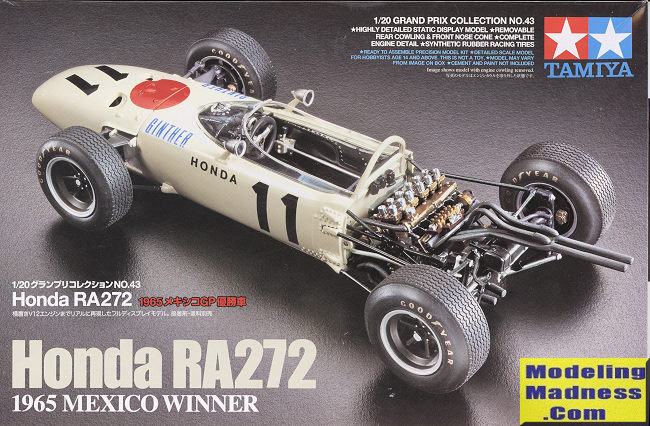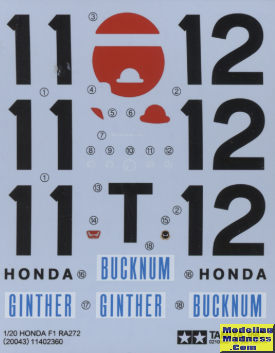
| KIT #: | 20043 |
| PRICE: | 2800 yen SRP |
| DECALS: | Two options |
| REVIEWER: | Scott Van Aken |
| NOTES: | 1996 release |

| HISTORY |
The Honda RA272 was a Formula One racing car used by the Honda team in the 1965 Formula One season.
A successor to the Honda RA271, the RA272 was noticeable mainly for its technically advanced (though rather wide and heavy) 48-valve 1,495.28 cc V12 engine (58.1 x 47.0 mm), a water-cooled, transversely mounted unit which reportedly gave 230 bhp (170 kW) at 13,000 rpm. The engine was safe to 14,000 rpm, which was unusually high for a 1960s engine design. The Honda V12 had staggering acceleration and often led the race into the opening lap after leaving the stationary starting grid. It led the 1965 Mexican Grand Prix from start to finish, driven by Richie Ginther, making it the first Japanese car to win a Formula One Grand Prix. It was somehow fitting the the last race of the 1.5 liter formula would be the first win for Honda. Honda won only one race in the new 3 liter formula before pulling out of F.1 at the end of the 1968 season.
The RA272 serves as the design influence for the B Dasher kart in Mario Kart DS.
The Honda racing team and the use of American drivers for the 1964 and 1965 seasons was the basis for the fictitious Yamura Racing Team in the movie Grand Prix.
| THE KIT |
I'm not sure if it was Tamiya that started using 1/20 scale for its F.1 racing cars, but it was a good choice. The resulting models are that much larger than the 'normal' 1/24 scale and it makes for a bit more detail and larger parts. If you have built any of Tamiya's 1/20 F.1 kits, you know that they are superb and have most of the detail you would want. They also require some care in building as one has to pretty well paint things prior to assembly, or at least after some subassemblies have been done.
Nowhere is this more obvious than in the engine with a multitude of different shades of metallics. One also has to pre-paint the suspension parts as F.1 cars, even in 1965, had the engine/transmission assembly attached to the rest of the monocoque via a sub-frame and in this case it is a welded tubular construct. With 12 cylinders, you know you'll have a fairly complex exhaust and Tamiya has managed to make this fairly straight-forward so you should, after cleaning seams, have a fairly fussy looking build.
Once that is done, the tub is constructed. This section holds the engine mount, front suspension, cooling system and the driver's compartments. To this gets attached the outer main body shell, which contains the instrument panel and steering wheel. I thought it would have been nice to have a seat harness included, even as a decal, but then realized that in 1965, these cars did not have one, so the omission is quite understandable.
 After the
main body is in place, the engine/transmission can be attached along with the
rest of the rear suspension pieces and the rear brakes. The kit is then finished
off by assembling and attaching the wheels, the very upper body, forward body
and the engine cover pieces. The engine cover is held in place by two screws so
one can remove it if one wishes to show off the engine. The tires have the
Goodyear logo prepainted onto them and the wheels are held in place by polycaps
hidden in the brake assembly.
After the
main body is in place, the engine/transmission can be attached along with the
rest of the rear suspension pieces and the rear brakes. The kit is then finished
off by assembling and attaching the wheels, the very upper body, forward body
and the engine cover pieces. The engine cover is held in place by two screws so
one can remove it if one wishes to show off the engine. The tires have the
Goodyear logo prepainted onto them and the wheels are held in place by polycaps
hidden in the brake assembly.
Instructions are superb as aways with Tamiya paint references. The decal sheet provides numbers for the cars of Bucknum and Ginther as raced in Mexico in 1965. This car is still extant and held in the Honda Museum so there are a lot of photos available to help with the build. I am sure that is where Tamiya went when developing this kit.
| CONCLUSIONS |
So here we have another great Tamiya F.1 car kit. Without building it I know that it will make into a superb model of this interesting early rear engine GP car.
| REFERENCES |
https://en.wikipedia.org/wiki/Honda_RA272
May 2019 Copyright ModelingMadness.com. All rights
reserved. If you would like your product reviewed fairly and fairly quickly, please
contact the editor
or see other details in the
Note to
Contributors. Back to the Main Page
Back to the Review
Index Page
Back to the Previews Index Page